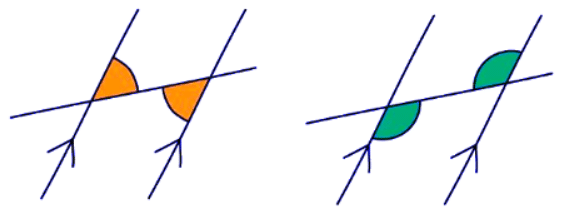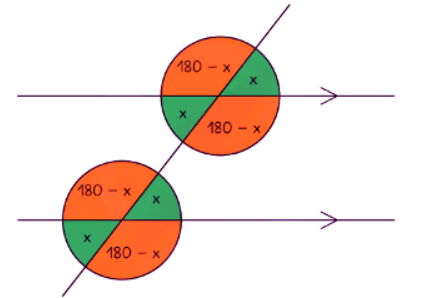Class 10 Exam > Class 10 Notes > Mathematics for GCSE/IGCSE > Angles in Parallel Lines
Angles in Parallel Lines | Mathematics for GCSE/IGCSE - Class 10 PDF Download
What are parallel lines?
- Parallel lines are lines that are always equidistant (i.e., the same distance apart) no matter how far the lines are extended in either direction; they will never meet.
What are the rules of angles in parallel lines?
There are 3 main rules:
1. Corresponding angles are equal:
- A line cutting across two parallel lines creates four pairs of equal corresponding angles, as shown in the diagram below.

- Note: You may also have heard these referred to as ‘F angles’ – do not use that term in an exam or you will lose marks!
2. Alternate Angles:
- When a line intersects two parallel lines, it creates pairs of alternate angles that are equal. These angles are illustrated in the diagram below:

- Note: You may also have heard these referred to as ‘Z angles’ – do not use that term on an exam or you will lose marks!
3. Allied (Co-Interior) Angles Add to 180°:
- When a line intersects two parallel lines, it forms pairs of co-interior angles.
- In the diagram provided, the two colored angles on either side add up to 180°.

- Note: These are referred to as either allied or co-interior angles, either is fine to use in the exam
- You may also have heard these referred to as ‘C angles’ – do not use that term on an exam or you will lose marks!
How to Apply Angle Rules in Parallel Lines?
- Identify angles that match and those that sum up to 180°.
- Step 1: Locate parallel lines on the diagram, usually marked with arrows or within a 2D shape with parallel lines.
- You might need to identify them based on other clues like vectors.
- Step 2: Identify the transverse line that spans across the parallel lines.
- Step 3: Use the given information and rules to find angles at the intersection of the transverse and parallel lines.
- For each transverse crossing a pair of parallel lines, there are four pairs of equal angles.
- Each pair adds up to 180°.
- Step 4: Fill in the angles until you find the desired one.
- Once you find the first angle, x degrees, the rest will either be x° or they will be 180° - x°.

The document Angles in Parallel Lines | Mathematics for GCSE/IGCSE - Class 10 is a part of the Class 10 Course Mathematics for GCSE/IGCSE.
All you need of Class 10 at this link: Class 10
|
82 videos|394 docs|60 tests
|
FAQs on Angles in Parallel Lines - Mathematics for GCSE/IGCSE - Class 10
| 1. What are co-interior angles in parallel lines? |  |
Ans. Co-interior angles in parallel lines are a pair of angles on the same side of the transversal line but inside the parallel lines. They add up to 180 degrees.
| 2. How can we identify angles in parallel lines? |  |
Ans. To identify angles in parallel lines, look for relationships such as corresponding angles, alternate angles, interior angles, and exterior angles formed by the parallel lines and the transversal line.
| 3. What are the key points to remember about angles in parallel lines? |  |
Ans. The key points to remember about angles in parallel lines are the properties of corresponding angles, alternate angles, co-interior angles, and vertically opposite angles formed by intersecting lines.
| 4. How do we find angle measurements in parallel lines? |  |
Ans. To find angle measurements in parallel lines, use the properties of angles formed by parallel lines and a transversal line. Apply the rules of corresponding angles, alternate angles, co-interior angles, and vertically opposite angles.
| 5. Why is it important to understand angles in parallel lines for the Year 11 exam? |  |
Ans. Understanding angles in parallel lines is crucial for the Year 11 exam as it forms the basis for solving geometric problems related to parallel lines, transversal lines, and angles. It helps in developing problem-solving skills and applying geometric principles to real-world situations.
Related Searches




















